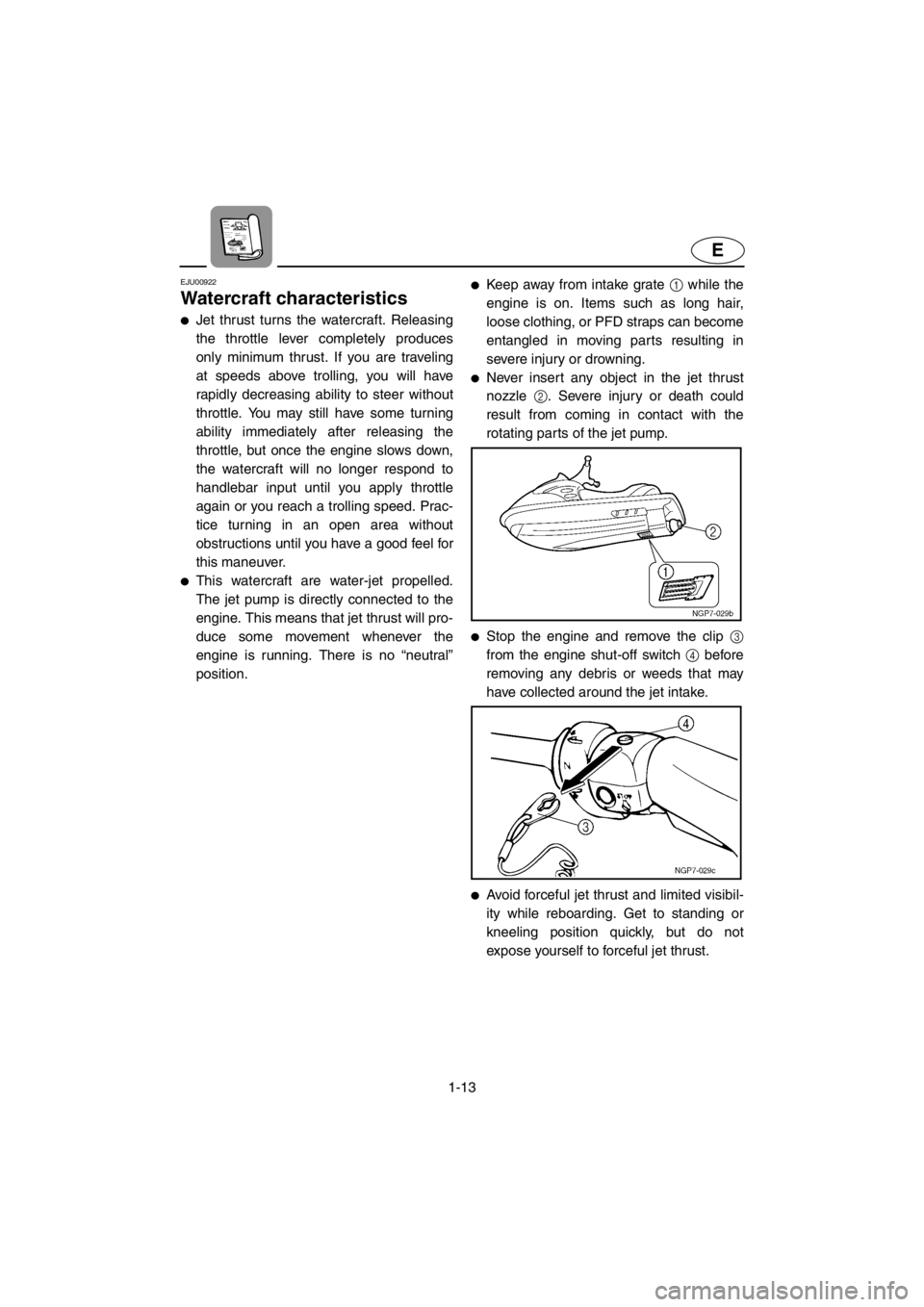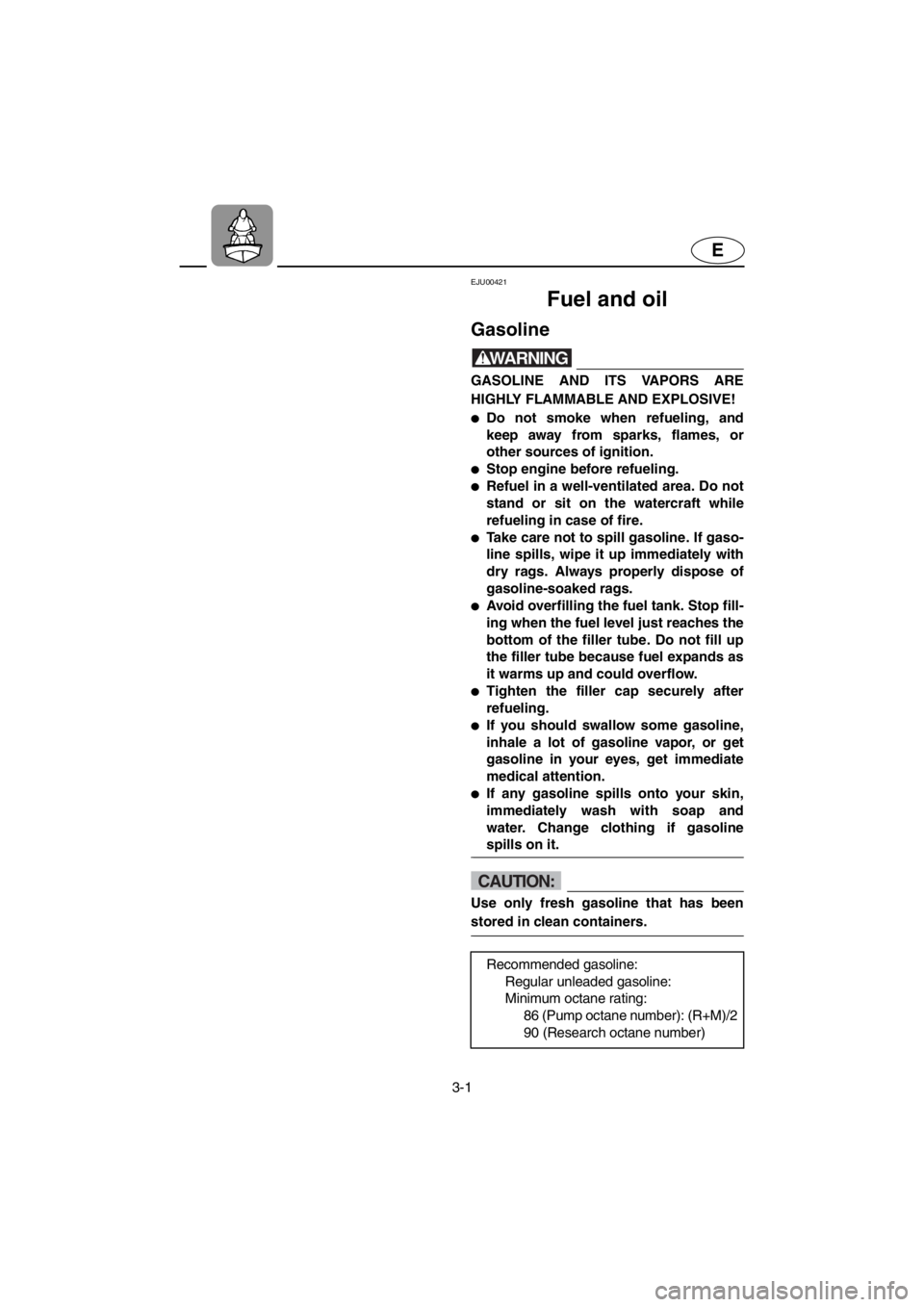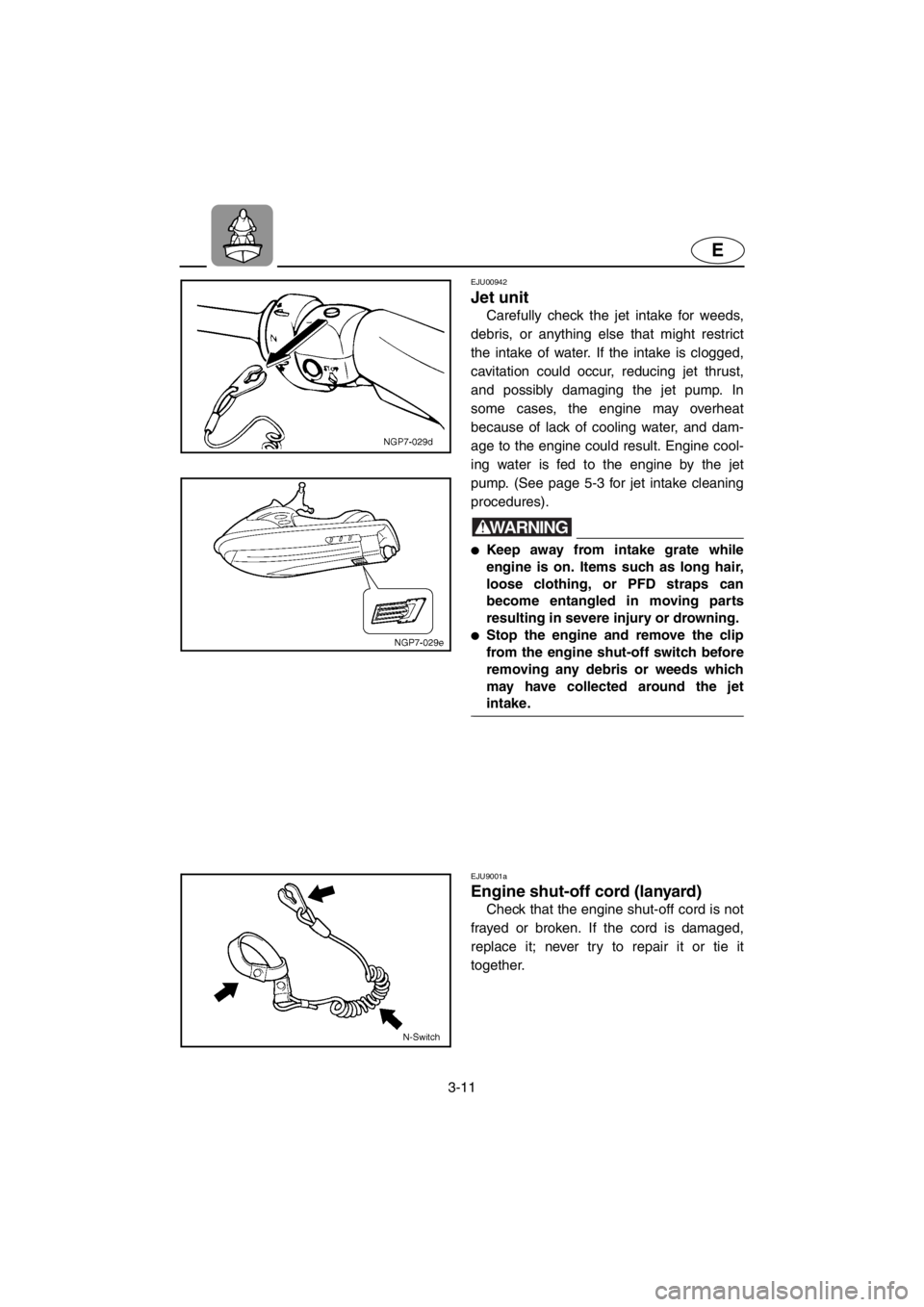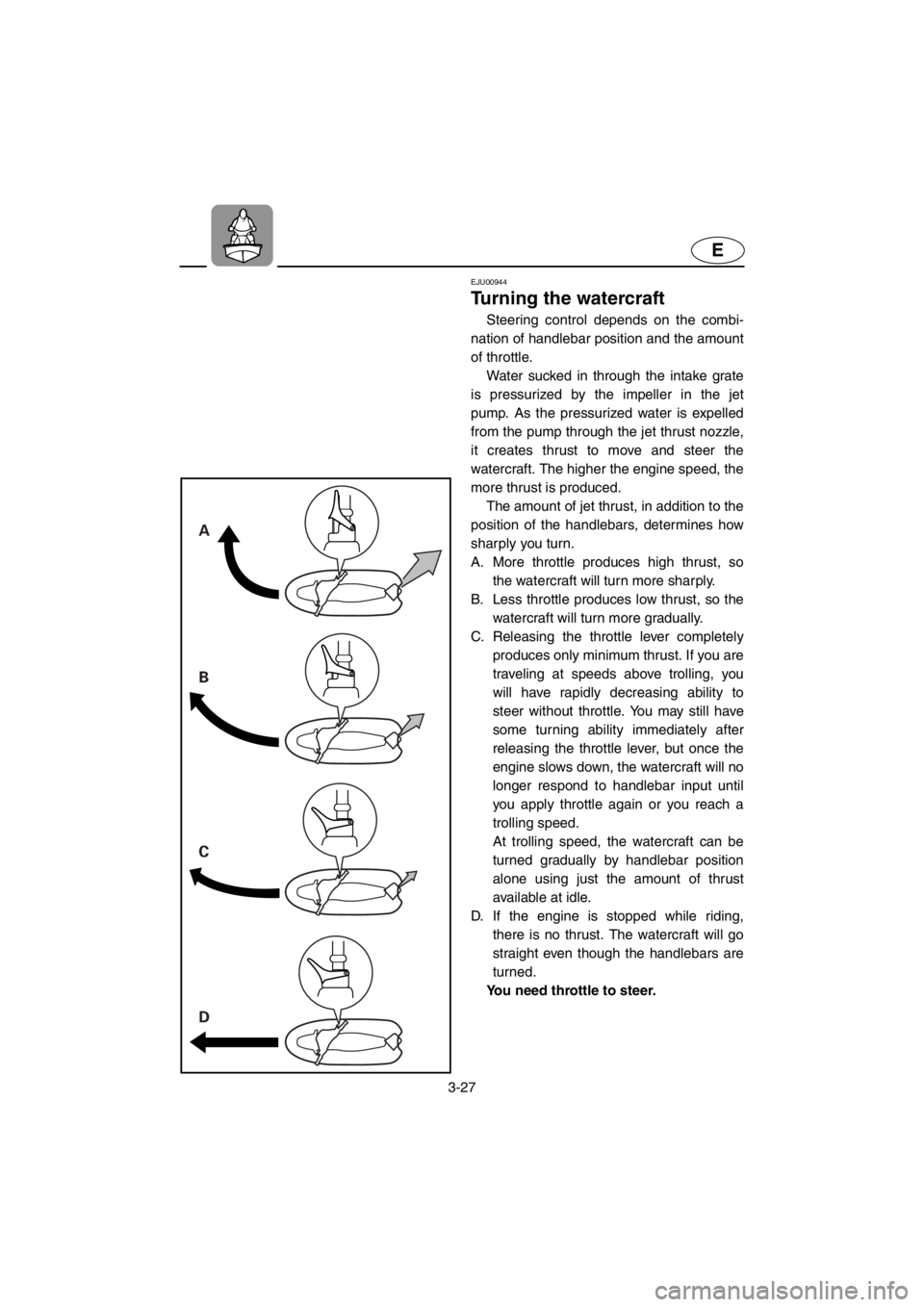Page 20 of 107

1-13
E
EJU00922
Watercraft characteristics
●Jet thrust turns the watercraft. Releasing
the throttle lever completely produces
only minimum thrust. If you are traveling
at speeds above trolling, you will have
rapidly decreasing ability to steer without
throttle. You may still have some turning
ability immediately after releasing the
throttle, but once the engine slows down,
the watercraft will no longer respond to
handlebar input until you apply throttle
again or you reach a trolling speed. Prac-
tice turning in an open area without
obstructions until you have a good feel for
this maneuver.
●This watercraft are water-jet propelled.
The jet pump is directly connected to the
engine. This means that jet thrust will pro-
duce some movement whenever the
engine is running. There is no “neutral”
position.
●Keep away from intake grate 1 while the
engine is on. Items such as long hair,
loose clothing, or PFD straps can become
entangled in moving parts resulting in
severe injury or drowning.
●Never insert any object in the jet thrust
nozzle 2. Severe injury or death could
result from coming in contact with the
rotating parts of the jet pump.
●Stop the engine and remove the clip 3
from the engine shut-off switch 4 before
removing any debris or weeds that may
have collected around the jet intake.
●Avoid forceful jet thrust and limited visibil-
ity while reboarding. Get to standing or
kneeling position quickly, but do not
expose yourself to forceful jet thrust.
E_GM6-1.fm Page 13 Tuesday, July 11, 2000 10:49 AM
Page 24 of 107
2-1
E
EJU00327
Location of main components
1Rope hole
Use to attach rope for transporting or mooring.
2Storage pouch
3Steering pole
Adjusts to suit operator’s riding posture.
4Handlebars
Use to control direction.
5Riding tray
Stand or kneel here for balance.
6Fuel tank filler cap
7Hood
8Steering cover9Hood latch
Locks the hood.
0Jet thrust nozzle
Changes the direction of jet thrust according
to handlebar position to steer the watercraft.
ACooling water pilot outlet
Use to verify cooling water flow.
BIntake grate
Prevents debris from getting into the jet pump.
CJet intake
DRide plate
EDrive shaft
Transmits power from the engine to the jet
pump.
E_GM6-2.fm Page 1 Tuesday, July 11, 2000 10:51 AM
Page 32 of 107
2-9
E
EJU00943
Engine overheat warning
system
This model is equipped with an engine
overheat warning system. If the engine
starts to overheat, the engine speed will be
limited to about 3,000 r/min.
When this occurs, check for water dis-
charge at the cooling water pilot outlet. If
there is no discharge of water, reduce the
engine speed and beach the watercraft, and
then check the intake grate and impeller for
clogging.
WARNING@Before attempting to remove weeds or
debris from the intake grate or impeller,
shut the engine off and remove the clip
from the engine shut-off switch. Severe
injury or death could result from coming
in contact with the rotating parts of the
jet pump.
@
CAUTION:@If you cannot locate and correct the
cause of the overheating, consult a
Yamaha dealer. Continuing to operate at
higher speeds could result in severe
engine damage.
@
E_GM6-2.fm Page 9 Tuesday, July 11, 2000 10:51 AM
Page 36 of 107

3-1
E
EJU00421
Fuel and oil
Gasoline
WARNING@GASOLINE AND ITS VAPORS ARE
HIGHLY FLAMMABLE AND EXPLOSIVE!
●Do not smoke when refueling, and
keep away from sparks, flames, or
other sources of ignition.
●Stop engine before refueling.
●Refuel in a well-ventilated area. Do not
stand or sit on the watercraft while
refueling in case of fire.
●Take care not to spill gasoline. If gaso-
line spills, wipe it up immediately with
dry rags. Always properly dispose of
gasoline-soaked rags.
●Avoid overfilling the fuel tank. Stop fill-
ing when the fuel level just reaches the
bottom of the filler tube. Do not fill up
the filler tube because fuel expands as
it warms up and could overflow.
●Tighten the filler cap securely after
refueling.
●If you should swallow some gasoline,
inhale a lot of gasoline vapor, or get
gasoline in your eyes, get immediate
medical attention.
●If any gasoline spills onto your skin,
immediately wash with soap and
water. Change clothing if gasoline
spills on it.
@
CAUTION:@Use only fresh gasoline that has been
stored in clean containers.
@
Recommended gasoline:
Regular unleaded gasoline:
Minimum octane rating:
86 (Pump octane number): (R+M)/2
90 (Research octane number)
E_GM6-3.fm Page 1 Tuesday, July 11, 2000 10:52 AM
Page 46 of 107

3-11
E
EJU00942
Jet unit
Carefully check the jet intake for weeds,
debris, or anything else that might restrict
the intake of water. If the intake is clogged,
cavitation could occur, reducing jet thrust,
and possibly damaging the jet pump. In
some cases, the engine may overheat
because of lack of cooling water, and dam-
age to the engine could result. Engine cool-
ing water is fed to the engine by the jet
pump. (See page 5-3 for jet intake cleaning
procedures).
WARNING@●Keep away from intake grate while
engine is on. Items such as long hair,
loose clothing, or PFD straps can
become entangled in moving parts
resulting in severe injury or drowning.
●Stop the engine and remove the clip
from the engine shut-off switch before
removing any debris or weeds which
may have collected around the jet
intake.
@
EJU9001a
Engine shut-off cord (lanyard)
Check that the engine shut-off cord is not
frayed or broken. If the cord is damaged,
replace it; never try to repair it or tie it
together.
E_GM6-3.fm Page 11 Tuesday, July 11, 2000 10:52 AM
Page 51 of 107
3-16
E
3. Attach the clip 1 to the engine shut-off
switch 2. Also, attach the engine shut
off cord 3 to your wrist.
WARNING@Check that the engine shut-off cord is not
frayed or broken, and keep it free from
the handlebars so the engine stops if the
operator falls off. The engine shut-off
cord may not pull free if wrapped around
the handlebars when the operator falls
off, allowing the watercraft to continue to
run and cause an accident.
@
NOTE:@It is not possible to start the engine with the
clip removed from the engine shut-off
switch.
@
4. Pull and hold the choke knob all the way
out.
NOTE:@The choke should not be used when the
engine is warm.
@
5. While lightly squeezing the throttle lever,
push the start switch.
WARNING@On this watercraft, the engine is con-
nected directly to the jet pump. Starting
the engine immediately generates some
thrust. Apply only enough throttle to
keep the engine running.
@
E_GM6-3.fm Page 16 Tuesday, July 11, 2000 10:52 AM
Page 62 of 107

3-27
E
A
B
C
D
EJU00944
Turning the watercraft
Steering control depends on the combi-
nation of handlebar position and the amount
of throttle.
Water sucked in through the intake grate
is pressurized by the impeller in the jet
pump. As the pressurized water is expelled
from the pump through the jet thrust nozzle,
it creates thrust to move and steer the
watercraft. The higher the engine speed, the
more thrust is produced.
The amount of jet thrust, in addition to the
position of the handlebars, determines how
sharply you turn.
A. More throttle produces high thrust, so
the watercraft will turn more sharply.
B. Less throttle produces low thrust, so the
watercraft will turn more gradually.
C. Releasing the throttle lever completely
produces only minimum thrust. If you are
traveling at speeds above trolling, you
will have rapidly decreasing ability to
steer without throttle. You may still have
some turning ability immediately after
releasing the throttle lever, but once the
engine slows down, the watercraft will no
longer respond to handlebar input until
you apply throttle again or you reach a
trolling speed.
At trolling speed, the watercraft can be
turned gradually by handlebar position
alone using just the amount of thrust
available at idle.
D. If the engine is stopped while riding,
there is no thrust. The watercraft will go
straight even though the handlebars are
turned.
You need throttle to steer.
E_GM6-3.fm Page 27 Tuesday, July 11, 2000 10:52 AM
Page 79 of 107
4-10
E
EJU00537
Inspecting the fuel system
WARNING@Gasoline and its vapors are highly flam-
mable and explosive.
@
Check the fuel system for leakage,
cracks, or malfunctions. If any problem is
found, do the necessary repair or replace-
ment as required. If repair is necessary, con-
sult a Yamaha dealer.
Check:
●Carburetors for leakage.
●Fuel pump for malfunction or leakage.
●Fuel tank for water or dirt.
●Fuel tank for damage, cracks or leakage.
●Fuel hose joint for leakage.
●Fuel hose for cracks or other damage.
●Fuel filter for leakage.
●Fuel cock for leakage.
●Air vent check valve for leakage.
WARNING@Failure to check for and repair any fuel
leakage may result in fire or explosion.
@
E_GM6-4.fm Page 10 Tuesday, July 11, 2000 11:28 AM